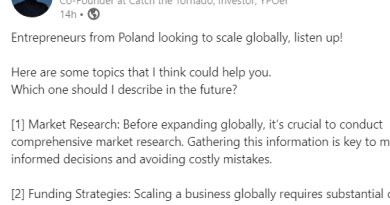Before you pitch, calculate Your Startup’s TAM, SAM, and SOM
Credit : Simona Alice Huebl via Linkedin
Angel investors and VCs want to see a breakthrough product or service that can acquire a significant share of a sizable market.
When you present your market size data to investors, many will look for:
TAM – Total Addressable Market
SAM – Serviceable Available Market
SOM – Serviceable Obtainable Market
These data points can appear colossal and out of reach, but if you approach market sizing methodically, you’ll realize it’s really not that complicated.
Marjorie Radlo-Zandi, an entrepreneur and angel investor, shared the TAM, SAM, and SOM on the olives and peppers industry below.
This can help you gain a better understanding of calculating the size of the market you’re targeting.
Calculating a realistic TAM, SAM, and SOM will help you:
✔ eliminate financial projections guesswork
✔ show prospective investors how they stand to gain
✔ know what you’re after
Credit: Marjorie Radlo-Zandi via TechCrunch :
At any stage of investment, whether seed or a Series B, it’s necessary to include a slide in your pitch deck that explains the
size of your market from three perspectives — TAM, SAM and SOM.
Step 1: Capture TAM (Total Addressable Market)
You can calculate TAM 3 different ways.
- The top-down approach, often attained through publicly available market research reports or extrapolated from
publicly available data reports. - The bottom-up approach, which relies on a calculation of actual and projected pricing, along with the current and
total projected use of your products or services. - The value theory approach. This theory applies an educated analysis of the projected value and total anticipated use
of your product or service, followed by calculating how much of that value can be reflected in its pricing. Value
theory most often applies to entirely new products, services and categories.
Recommended Approach: Hire a seasoned market research consultant to secure TAM data using either a bottom-up or value
theory approach.
“Olives and peppers” is a well-researched category in plant-based foods within the specialty foods space. The TAM for
specialty foods in the U.S. is $146 billion.
Don’t be surprised by the seemingly astronomical number, and don’t spend too much time thinking about it. Only be concerned
if the number is small. The TAM number gives investors an overall macro perspective of your company’s potential.
You’ll find the TAM for your technology through credible market research companies such as Frost & Sullivan, Nielsen,
Statista and Gartner. You may not even be required to pay for a report because the TAM data you need is likely available in
one of these companies’ abstracts. Copy and paste the data into your spreadsheet and move on to SAM.
Step 2: Secure SAM (Serviceable Available Market)
Continuing with our olives-and-peppers example, within the larger U.S. specialty foods space is the plant-based foods
category. Plant-based foods is the SAM category, or service available market, of specialty foods.
For olives and peppers, plant-based foods within the specialty food category, SAM is valued at $7 billion. Again, tap the
aforementioned market research organizations to obtain your SAM number. Copy and paste the SAM data into your
spreadsheet and progress to SOM.
Step 3: Calculate SOM (Serviceable Obtainable Market) – your share of the market over time
Pour your calculation efforts into SOM. In our U.S. plant-based foods example, the SOM would be the $2.5 billion “olives and
peppers” product category of the U.S. plant-based market.
Investors really care about a product category’s SOM. The olives-and-peppers company’s quest here is to estimate how much
of the U.S. olive-and-peppers market they can capture in the next 5 to 10 years. They could estimate capturing 0.5% of U.S.
market share in year one of shipping the product, 1% in year two, 3% in year three, and so on.
To get more specific about your market share over time, consider bottom-up forecasting. You calculate a bottom-up forecast
by estimating expected and potential sales.
Estimate how quickly you’ll obtain a share of the market and at what rate over defined periods of time. Also look for how much
competition you anticipate, challenges the competition is likely to pose, and other potential obstacles or barriers to entry.
Going back to the olives-and-peppers example, we can estimate sales to 75 specialty stores in year one, 200 in year two,
500 in year three, and so on. Multiply the amount of product you anticipate you’ll sell to these stores by month and year. It’s
that simple.
To refine your calculation process, speak with potential customers, market research consultants, industry leaders, board
members and advisers in your space. Gather information through conversations with CEOs in the same industry whose
companies have complementary products. This information will be vital to determine the market penetration rate of your
product.
Your SOM calculations are integral to the sales cycle along with the sales close rate you anticipate. Don’t inflate your
estimates, because investors will expect you to achieve these numbers. When your company has revenues, not achieving
estimates can come back to bite you in the form of diminished credibility with investors, and potentially tank your ability to
secure funding







